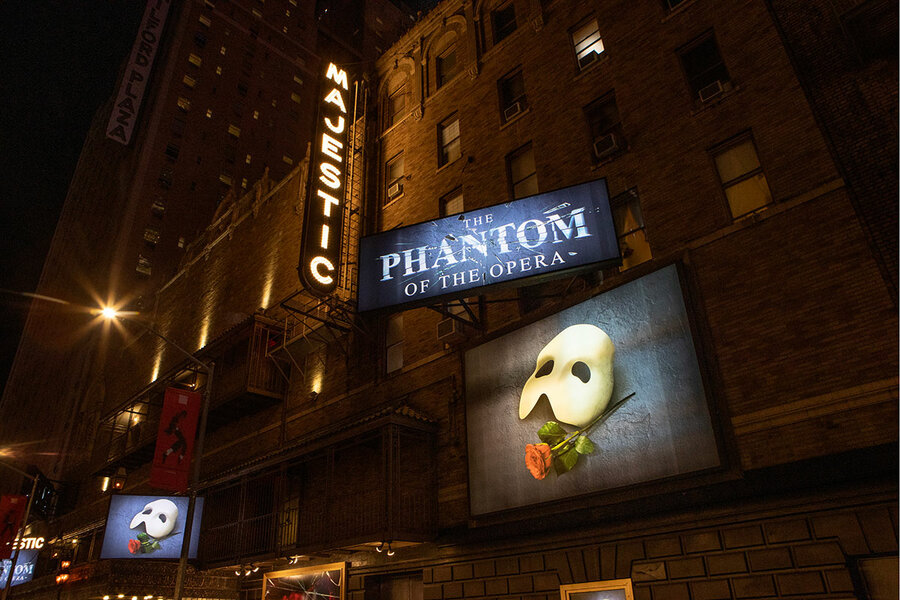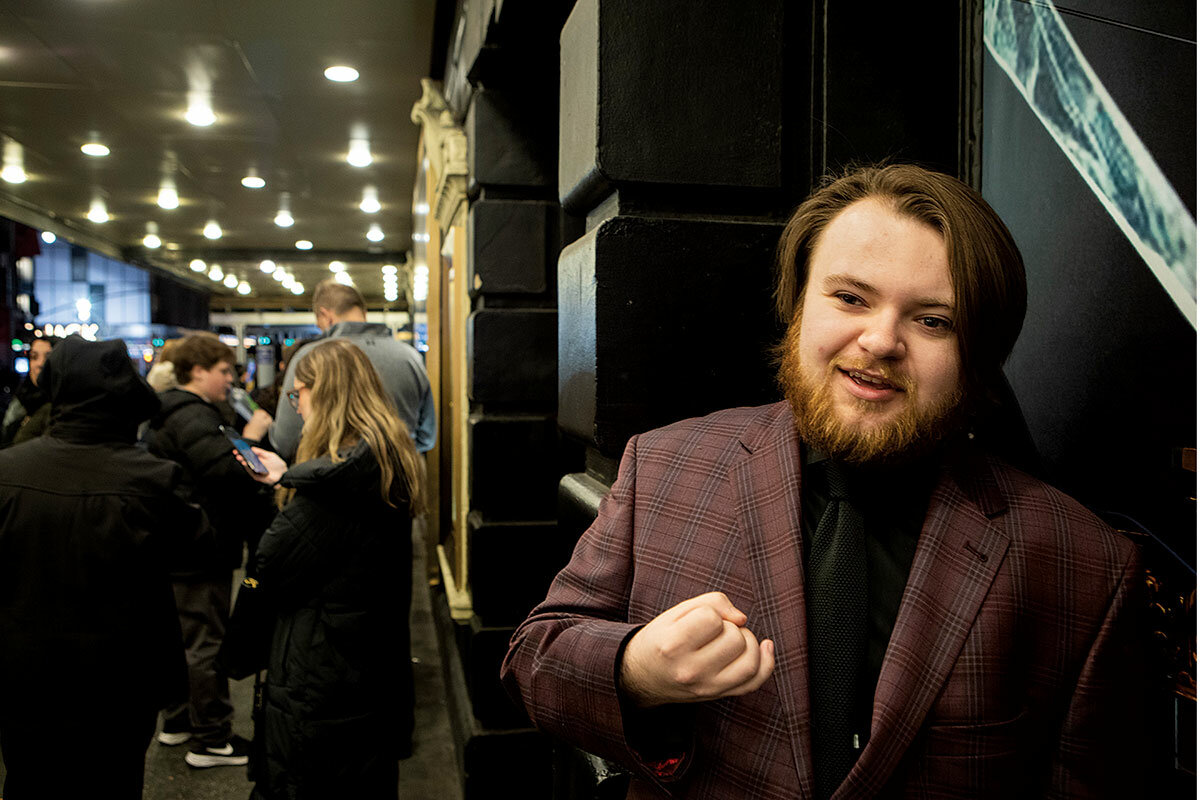On Broadway, saying goodbye to ‘Phantom’
Loading...
| New York
On a midweek night, Noah Boice is one of the first people waiting in line outside the Majestic Theatre. He’s flown here from Detroit to see “The Phantom of the Opera.” After 35 years, Andrew Lloyd Webber’s epochal musical is about to end its historic run on Broadway.
“I’ve wanted to see it ever since I was a little kid,” says the chef. “In high school I wanted to audition for ‘Phantom.’ I didn’t get the role, unfortunately, because I don’t have the voice.”
Dressed for the occasion in a tartan suit that complements his red beard, he’s taking in the scene of his pilgrimage. Above the theater marquee, a digital billboard displays the most recognizable iconography on Broadway: a white mask next to a red rose. They symbolize the love story of a beautiful singer and a 19th-century musical genius who secludes himself because of his disfigured face.
Why We Wrote This
A story focused onThe allure of “The Phantom of the Opera” is about more than catchy songs. Decades of theatergoers have found personal connections to the story.
“Basically, the main story of it is don’t judge a book by its cover,” says Mr. Boice.
“Phantom” will leave behind a formidable legacy. An early prototype of the megamusical, it helped transform Broadway into a magnet for overseas tourists. The Majestic opted to shutter “Phantom” due to slow ticket sales after the pandemic. Ironically, the announcement of the musical’s closing created a surge in demand that, as of mid-March, has made “Phantom” the highest grossing musical on Broadway. The original end date was pushed back from February to April 16. For its many fans – or Phans – the production’s enduring popularity comes down to its memorable melodies and a universally relatable story about whether true love is skin deep.
“There’s just so many stories you hear at the stage door from people [about] the ways the show relates to them,” says Ben Crawford, who has played the titular character on Broadway since 2018, in a phone interview. “People who think they can resonate with the phantom if they feel different or they’re treated differently. There’s a connection there. So there’s a lot of things that people can personalize in the show.”
Thirty-five years ago, Broadway audiences were predominantly locals from the New York area. As productions became more expensive to mount, the theater industry was eager to internationalize its audience. Cue the dramatic organ fanfare (DUHN dun dun dun DUHN) and enter “Phantom.”
Mr. Lloyd Webber had already established himself a household name with mass appeal hits such as “Jesus Christ Superstar,” “Evita,” “Joseph and the Amazing Technicolor Dreamcoat,” and “Cats.” “The Phantom of the Opera” eclipsed them all.
The love duet “All I Ask of You” and “The Phantom of the Opera” – both Top 10 hits on the U.K. singles chart – are firmly embedded in millions of mental jukeboxes. It also spawned a 2004 movie version, starring Emmy Rossum and Gerard Butler, as well as several cast recordings from various stage productions – including the very first one in London in 1986.
“It’s a show that doesn’t date itself,” says Jessica Sternfeld, author of “The Megamusical.” “There’s enough of a sense of classical music about it that it doesn’t quite holler, ‘I’m from the 1980s,’ the way other shows do.”
Long before “The Lion King” roared on stage, “Phantom” employed Disney-like branding with a worldwide reach, says Elizabeth Wollman, author of “The Theater Will Rock: A History of the Rock Musical, from Hair to Hedwig.” In New York, where tourists accounted for 65% of pre-pandemic Broadway audiences, the $1.3 billion grosses for “Phantom” overall have only been surpassed by “Wicked” and “The Lion King.”
To understand the longevity of “Phantom,” Dr. Wollman suggests putting yourself in the mind of a first-time visitor to Broadway: “I’m with my family. I don’t know New York very well. I want something that’s comfortable that I’ve heard of before, that I think we’re all going to understand. That’s not going to be too risqué for my children. That’s not going to bore me to tears.”
Standing outside the Majestic, Zack and Sarah Inman from Bowling Green, Kentucky, are quick to praise Emilie Kouatchou, the first Black woman to play the role of Christine.
“She was actually Christine when we saw it in 2021,” says Ms. Inman. The couple have lost count of how many times they’ve seen “Phantom” either on tour or here in New York. “Seven or eight,” says Ms. Inman.
Emily Pringle, of Long Island, can boast an even higher number. She’s seen it 12 times. The first time was when she was 10 years old. Most recently, she attended the 35th anniversary performance on Jan. 26.
“They had confetti at the end,” says the student, who is at the theater filming a documentary about the show closing on Broadway. “Ben [Crawford] gave a really good speech at the end. Andrew Lloyd Webber was there.”
Attendees milling in the lobby have flown in from places like Massachusetts, Texas, and Missouri. The excited voices include Russian and Chinese tourists. The merch stand is doing robust business. Its memorabilia include a teddy bear dressed in a tuxedo, cape, and a mask – probably not the kind of thing one gives a toddler at bedtime.
“There’s this intrigue to the character of the Phantom,” says Yacine Ndaw, a New Yorker who first saw the show when she was 13. She’s drawn to a story that’s as unpredictable as the moment when the Phantom suddenly appears on a gangway high above the audience. “You watch the whole show and you understand a little bit more who he is.”
The masked character is a musical composer who’s been ostracized because of his facial deformity. Hiding in the catacombs of a Paris opera house, he demands that its new owners stage his latest work, “Faust.” He also insists that they cast a young singer, Christine, in the lead role. He’s infatuated with her. And he’s also jealous of Christine’s childhood friend, Raoul, who is wooing her. When things don’t go the Phantom’s way, he kills people. To some, the character is a troubling figure whose possessive stalking of Christine is abusive. Not to put too fine a point on it, but he is also a serial killer.
“If you just play him as the bad guy and the murdering sociopath, then you really lose a lot of the layers involved in the character,” says Mr. Crawford.
“You have to make sure that they understand the humanity aspect of him,” he adds. “And I think if you can find a way to show that he’s lashing out because he’s been mistreated his whole life, you don’t condone his behavior, but you can at least understand it.”
At the climax of the show – spoiler alert – Christine tells the unmasked composer, “This haunted face holds no horror for me now. It’s in your soul that the true distortion lies.” In an act of kindness, she embraces him.
He has a sort of revelation in that moment, it’s not the way he looks, but how he is, that makes him “unfit to live among us,” says Dr. Sternfeld, who is an associate professor of music at Chapman University in Orange, California.
At a February performance, it’s not the famous scene of a crashing chandelier that threatens to bring the roof down. It’s the extended applause during the encores. Afterward, Tony Bacigalupo stands outside the theater chatting with his wife, Christina, about the performance.
“I remember I leaned over to you at some point early on in the show and said, ‘Look, we’ve seen a lot of shows together, but this one is different,’” says Mr. Bacigalupo, a New Yorker. “They clearly were going for it. With this one, there was no holding back.”
Ms. Bacigalupo marvels at how the Phantom made her root for him despite his crimes. She “happy cried” at the end.
“For so many people, this got us into theater and wanting to come see more shows,” says the one-time college theater major. “It was nice to come and see it one last time and give it the respect it deserves.”
Editor’s note: A previous version of this story included comments about how often “Phantom” tours. “Phantom” has had long stretches on tour, but the show is not yet available to community and regional theaters.








